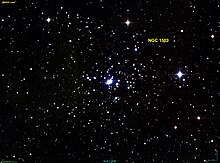NGC 1502 (also known as the Golden Harp Cluster[6]) is a young[7] open cluster of approximately 60[3] stars in the constellation Camelopardalis, discovered by William Herschel on November 3, 1787.[8] It has a visual magnitude of 6.0 and thus is dimly visible to the naked eye.[3] This cluster is located at a distance of approximately 3,500 light years[1][2] from the Sun, at the outer edge of the Cam OB1 association of co-moving stars, and is likely part of the Orion Arm.[2] The asterism known as Kemble's Cascade appears to "flow" into NGC 1502, but this is just a chance alignment of stars.[9]
 The location of NGC 1502 (circled) | |
| Observation data (J2000 epoch) | |
|---|---|
| Right ascension | 04h 07m 48.96s[1] |
| Declination | +62° 19′ 55.2″[1] |
| Distance | 3,452 ly (1,058.4 pc)[1] 3,643+313 −290 ly (1,117+96 −89 pc)[2] |
| Apparent magnitude (V) | 6.0[3] |
| Apparent dimensions (V) | 9.7′[1] |
| Physical characteristics | |
| Radius | 5.5 ly (1.7 pc)[4] |
| Estimated age | 5 Myr[2] |
| Other designations | NGC 1502,[5] Cr 45 |
| Associations | |
| Constellation | Camelopardalis |

The Trumpler class of NGC 1502 is II3p, indicating poorly populated cluster of stars (p) with a wide brightness range (3). The main sequence turnoff point is not well-defined, so the age estimates range from five to fifteen million years.[7] It is heavily reddened due to interstellar dust.[4] One of the brightest candidate members of the cluster is the eclipsing binary SZ Cam, which is a component of a visual double star ADS 2984.[2] There are eleven variable stars and four candidate variables among the cluster members, including a β Cep, two periodic B-type variables, 2–3 eclipsing variables, and an RR Lyrae star.[7] Five members of the cluster are chemically peculiar.[10]
See also
- Alpha Camelopardalis, a runaway star possibly ejected from this cluster.[7]
References
External links
 Media related to NGC 1502 at Wikimedia Commons
Media related to NGC 1502 at Wikimedia Commons- NGC 1502 on WikiSky: DSS2, SDSS, GALEX, IRAS, Hydrogen α, X-Ray, Astrophoto, Sky Map, Articles and images
